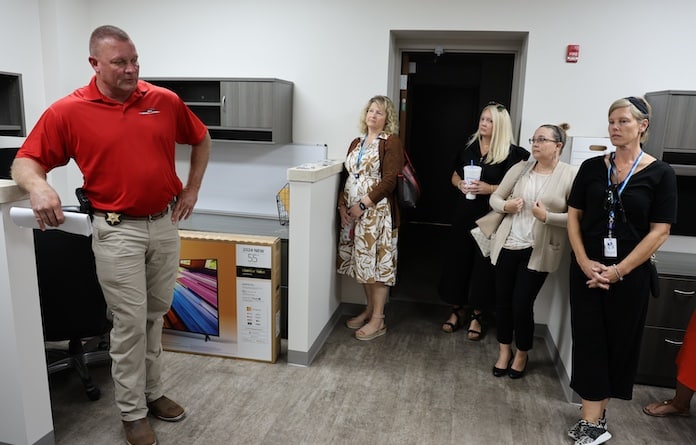Coalition tours renovated MCSD

The Monroe County Coalition for Drug-Free Communities held its regular meeting at the Monroe County Sheriff’s Department, discussing drug-related crime in the county before taking a look at recent renovations to the building.
At the top of the meeting, Monica Kirkpatrick introduced herself as the coalition’s newly hired executive director, stepping in for Kacie Woods who started in the position in February.
Kirkpatrick also introduced Christy Gardner as the coalition’s new youth director, focusing on working with students in the county in a number of ways, including the group’s youth-leadership effort Project Snowball.
Monroe County Sheriff Neal Rohlfing served as the meeting’s guest speaker, leading a discussion on a number of matters pertaining to crime and substance abuse in the community.
He first noted that upwards of 70 percent of arrests made by the MCSD involve individuals who are not Monroe County residents.
While Rohlfing pointed to the fairly relaxed and friendly nature of the county – many residents feeling comfortable to leave their cars unlocked on the street – population growth and proximity to the St. Louis metro area have contributed to some individuals coming to Monroe County for criminal activity.
“As we continue to turn into a metropolitan area, we are starting to see more and more of the metropolitan problems,” Rohlfing said. “A lot of people here are still thinking it’s Monroe County of 1995. It’s just not.”
Rohlfing also mentioned Illinois’ SAFE-T Act, which he has spoken against previously on numerous occasions.
He indicated that the act, particularly the removal of cash bail in the state, seems to have had an impact on thefts and burglaries locally, with such crimes up by about 50 percent within the county and about 65 percent in Columbia specifically.
Rohlfing further spoke about the no cash bail component of the act, saying that a number of individuals the department has arrested since the act went into effect have described Illinois as a “catch and release” state.
“It’s out. The criminal element is talking about it,” Rohlfing said. “You don’t want to get caught if you’re a criminal, but why would you steal in Missouri when you can come here and load up at Walmart or steal out of anyone’s garage, and for sure you’re going home the next morning.”
With the apparent uptick in thefts, Rohlfing did add that violent crime is far from a concern in this county.
When it comes to drug-related crimes, Rohlfing pointed to statistics from last year noting that there were 57 methamphetamine arrests and 32 controlled substance arrests, with this year appearing to be comparable with 20 meth and 19 controlled substance arrests so far.
“I would suspect we’ll probably be somewhere similar to those numbers for the end of the year,” Rohlfing said.
Rohlfing went on to share additional statistics for department activity, with 17,261 calls for service last year and 12,488 calls so far this year. He added that these numbers have continued to go up over the years, nearly tripling since he took office in 2014.
He also touched on activity along Route 3, with a deputy set to be assigned specifically to look for potential narcotics transportation and other crime coming through this corridor into the county.
Speaking more on drugs in the county and the country, Rohlfing said the way the nation’s southern border is being handled is vital when it comes to determining how many narcotics enter the U.S.
With the influx of drugs, he said the street price of cocaine, meth and other narcotics has actually gone down in recent years.
“You’re at the point now where you can get 2.5 grams of cocaine… for $100, and 20, 30 years ago it was $100 for one gram,” Rohlfing said. “It is cheaper now, and we’ve never seen that before, ever. It’s bad.”
Toward the end of his speech, Rohlfing addressed a number of questions from those in attendance while also further touching on a few smaller items.
He said over 80 percent of inmates held at the county jail suffer from some sort of addiction or have another mental illness problem.
Age demographics for those possessing narcotics in Monroe County are varied, with extremes on both ends, though youth getting caught with some drug rarely have anything harder than weed.
Cannabis was a particular topic of concern toward the end of the discussion as it is a major focus of the coalition given how it has become tremendously normalized online and can, like many other substances, impact brain development in young people.
Following the regular meeting, Rohlfing led those in attendance around the sheriff’s department to show some of the recent renovations.
Among the highlights of the tour were the new offices for Rohlfing and the department’s detectives and other personnel.
Rohlfing noted one former office which previously housed two members of the department. This room is so small that it is being relegated to a closet following the renovations.
The department’s renovations also include a new training room – Rohlfing noted how the sheriff’s department has had to work with other emergency response departments in the area to find space for training.
He also highlighted the department’s new break room. The previous break room, he said, was also where personnel packaged evidence, with officers eating their lunch in the same room that fentanyl was sometimes prepared for storage.
On this topic, Rohlfing also showed the still unfinished evidence storage and processing rooms which should allow for much more space as the existing evidence room was, as Rohlfing described, stacked to the ceiling.






